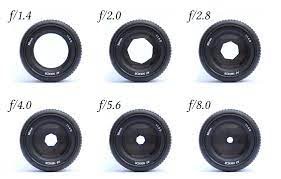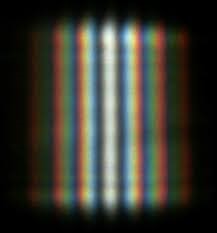Introduction
An aperture refers to an opening or a hole through which light passes. Lenses, telescopes, cameras, microscopes, and fiber optic systems use optical apertures. The size and shape of the aperture significantly impact the behavior of light within an optical system as well as its performance.
a. Definition
An optical aperture is a component that serves as a boundary that limits the extent of light entering or exiting the optical system. It determines the size of the cone of light rays that contribute to the formation of the image.
b. Key Parameters of an Optical Aperture
Several key parameters of optical apertures are aperture size, shape, placement, mechanism, ratio or f-number, and transmission characteristics.
1. Aperture Size
The aperture size is the most important parameter of an optical aperture. It determines the amount of light passing through the system, and it is usually specified as the diameter of the aperture opening. However, in optics, it is often more convenient to express the aperture size using the f-number (also known as the focal ratio). The f-number is the ratio of the focal length of the lens or system to the diameter of the aperture.
2. F-number/F-ratio
The f-number (f/) of optical apertures is a parameter that describes the relative size of the aperture in relation to the focal length of a lens or optical system. The f-number is the focal length of the lens divided by the diameter of the aperture and characterizes the light-gathering capability and depth of field of a lens or optical system. A smaller f-number indicates a larger aperture relative to the focal length, which allows more light to pass through the system. This results in a brighter image and a shallower depth of field, where only a narrow range of distances appears in sharp focus. On the other hand, a larger f-number indicates a smaller aperture relative to the focal length, resulting in less light passing through the system, a dimmer image, and a deeper depth of field, where a larger range of distances appears in focus.
The f-number is an essential parameter in photography, as it influences exposure settings and affects the balance between light gathering, depth of field, and image sharpness. It is also relevant in other optical applications, such as telescopes, microscopes, and digital cameras, where it helps in understanding the performance and characteristics of the optical system.

Aperture Size versus f-number. The wider the aperture opening, the smaller the f-number. Courtesy of Wikipedia.
3. Aperture Placement
This refers to the location of the aperture within an optical system. It can be positioned at different locations, such as in front of the lens (front aperture) or within the lens assembly (internal aperture). The placement of the aperture is a key parameter as it can influence the performance of the system substantially. For instance, the position of the aperture affects the occurrence of vignetting, which is the darkening of image corners. When placed too close to the lens, especially in wide-angle lenses, it may obstruct some of the light rays reaching the edges of the image sensor or film, leading to darkened corners or uneven illumination. Proper placement helps minimize vignetting and ensures uniform light distribution across the image.
4. Aperture Transmission
The transmission characteristics of an aperture describe how it interacts with incident light or waves. The size of the aperture affects the amount of light that can pass through it, with larger apertures generally allowing higher transmission efficiency. Diffraction effects occur when light passes through an aperture, causing the light waves to spread out and interfere. The shape of the aperture determines the transmission pattern, such as circular or rectangular distributions. It can also act as a spatial filter, selectively allowing certain spatial frequencies or angular components to pass through.
Moreover, apertures can influence the polarization of transmitted light. Understanding these transmission characteristics is vital for optimizing optical systems in applications such as imaging, microscopy, telecommunications, and laser systems.
Types of Apertures
There are several types of optical apertures used in various optical instruments and devices. The section below discusses some of the most widely used apertures in the field of optics.
a. Circular Aperture
The most common type of aperture is a fixed circular aperture. It is a fixed circular opening in cameras, microscopes, and telescopes. Pinhole apertures are an example of circular apertures that are typically small in size and that are commonly used to create an image by diffraction.
b. Rectangular Aperture
A rectangular aperture has a rectangular shape and is often used in imaging systems, such as cameras and projectors. It offers greater control over the shape and orientation of the light beam compared to a circular aperture.
c. Iris Diaphragm
An iris diaphragm is a type of adjustable aperture that consists of thin overlapping metal blades arranged in a circular pattern. Adjusting the size of the central opening allows controlling the amount of light passing through. Diaphragms are commonly found in cameras, microscopes, and other optical instruments.
d. Variable Aperture
A variable aperture, as the name suggests, is an aperture that can be adjusted to change its size. It offers flexibility in controlling the amount of light entering the system. This is particularly useful in photography, where aperture settings affect depth of field and exposure.
e. Grating Aperture
A grating aperture is a specialized aperture that contains a series of closely spaced parallel slits or gratings. It is used in spectroscopy and diffraction applications to separate light into its constituent wavelengths or diffract it into specific patterns. Grating apertures are commonly used in spectrometers and monochromators.
f. Fiber Optic Aperture
In fiber optic systems, the aperture refers to the opening through which light enters or exits an optical fiber. The aperture size affects the amount of light coupled into or out of the fiber. Fiber optic apertures are critical for efficient light transmission and coupling in fiber optic communication systems and optical sensors.
Importance of Apertures in Photography
Optical apertures are not just about controlling the amount of light that enters the camera. They also have a significant impact on the image’s overall quality and creative possibilities. One of the primary considerations when using apertures is exposure. By adjusting the size of the aperture, photographers can fine-tune the amount of light hitting the camera’s sensor or film. This control is particularly crucial in situations with varying lighting conditions, such as shooting outdoors on a sunny day or in low-light environments. The ability to adjust the aperture allows photographers to achieve proper exposure, ensuring that the image is neither too dark nor too bright.
Beyond exposure, apertures play a pivotal role in shaping the depth of field. The depth of field refers to the range of distance in an image that appears acceptably sharp or in focus. It allows photographers to selectively emphasize the subject by either isolating it from the background or maintaining focus throughout the entire scene. A wider aperture (smaller f-number) creates a shallow depth of field, blurring the background and drawing attention to the subject. This technique is popular in portrait photography, where the subject is in sharp focus while the background is pleasantly out of focus, creating a pleasing separation between the two. It also lends itself well to close-up or macro photography, where capturing intricate details while minimizing distractions is crucial.
On the other hand, a narrower aperture (larger f-number) produces a greater depth of field, resulting in a larger area of the image appearing sharp and in focus. Landscape photography often uses this technique where the photographer wants to capture a scene with maximum sharpness throughout. By using a smaller aperture, photographers can ensure that both the foreground and background elements are in focus. This enables viewers to appreciate the entire scene in detail.
The Bokeh Effect
The bokeh effect is created by the interaction of the lens aperture, the out-of-focus areas in the scene, and the lens design. When using a wide aperture, such as f/1.8 or f/2.8, the lens opening becomes larger, allowing more light to enter the optical system. This wide aperture results in a shallower depth of field, where the area in front of and behind the focused subject appears blurred. When a scene contains out-of-focus points of light, such as distant streetlights or sparkling reflections, these points of light render as small circles or shapes in the image. The shape of these circles is influenced by the design of the lens aperture. If the lens has a rounded and well-designed aperture with curved blades, the out-of-focus points of light are rendered as smooth and round bokeh balls. The aperture’s blade configuration determine the size and shape of the bokeh balls.
Lenses with more aperture blades tend to produce smoother and more circular bokeh, while lenses with fewer blades may create polygonal or angular bokeh shapes. The contrast between the sharp subject in focus and the soft, blurred background enhances the visual impact of the bokeh effect, drawing attention to the subject and creating a pleasing aesthetic.
By controlling the aperture setting, photographers can manipulate the bokeh effect to achieve different creative results, such as emphasizing the subject or creating a dreamy, magical atmosphere.

Example of the Bokeh Effect on Street Lights. As described above, achieving this effect results in an out-of-focus background. Courtesy of Wallpaper Flare.
The Interplay of Aperture, Shutter Speed, and ISO
In photography, the optical aperture, shutter speed, and ISO are interrelated parameters that collectively determine the exposure and image quality. The optical aperture, represented by the f-number, controls the amount of light entering the camera, with larger apertures allowing more light. Shutter speed influences the duration of light exposure onto the image sensor, with faster speeds reducing exposure time. ISO represents the sensor’s sensitivity to light, with higher values increasing sensitivity. These parameters are interconnected: larger apertures can be compensated by faster shutter speeds, while smaller apertures may require slower speeds. Additionally, larger apertures may allow for lower ISO settings, while smaller apertures may necessitate higher ISO values. Balancing these parameters is essential to achieve proper exposure and desired image characteristics.
Influence of Apertures on Aberrations
Optical apertures play a critical role in optical systems, exerting significant influence on aberrations that can degrade image quality. When light passes through small apertures, such as circular or pinhole apertures, diffraction effects occur, causing the bending and spreading of light waves. This diffraction can lead to blurring and reduced image sharpness. Stops, including field stops and pupil stops, are normally within the optical system to control the passage of light. However, improper placement or sizing of these stops can introduce vignetting, resulting in non-uniform illumination and potential image distortion. Adjusting the aperture size allows mitigating spherical aberration, caused by the inherent shape of optical elements with spherical surfaces. Larger apertures can exacerbate spherical aberration, particularly towards the edges of lenses, causing blurring and loss of sharpness. Stopping down the aperture brings down the the impact of oblique and spherical aberrations.
Additionally, the size and shape of the aperture can affect the severity of coma and astigmatism, aberrations that cause distortions and elongations in point sources of light, particularly towards the edges of the image. Careful consideration of aperture parameters, such as size, shape, and position, is crucial in optical system design to minimize aberrations and achieve optimal image quality.
Aperture Quality
Multiple factors determine the quality of an optical aperture. First and foremost, a high-quality aperture should have precise and uniform dimensions. Accurate manufacturing and maintenance of the aperture’s shape, size, and opening ensure consistent performance and minimize optical distortions or uneven light transmission. Additionally, the surface of the aperture should be smooth and free from defects or scratches. Roughness, or particles on the aperture can cause light scattering or diffraction, leading to reduced image sharpness and unwanted artifacts. High-quality apertures are carefully fabricated and handled to maintain cleanliness and smoothness.
Another crucial aspect is the optical transmission properties of the aperture. It should allow a significant amount of light to pass through without significant loss. Materials used for the aperture should have low absorption and minimal scattering characteristics to maximize light transmission and enhance image brightness and clarity. Moreover, if the aperture is adjustable, the quality of the control mechanism is essential. The mechanism should enable smooth and precise adjustment without introducing vibrations or inconsistencies, allowing for accurate exposure control and depth of field adjustments. Finally, a high-quality aperture should be resistant to environmental factors such as temperature changes, humidity, and chemical exposure. It should withstand these conditions without deforming, corroding, or compromising its performance. Overall, a high-quality optical aperture ensures accurate light control, minimal aberrations, optimal image quality, and reliable performance in various optical systems and applications.
Diffraction of Light by an Aperture
Diffraction occurs when light encounters apertures or obstacles because of the wave nature of light. Light is an electromagnetic wave. When it interacts with an object with a size comparable to its wavelength, the wavefronts bend and spread out around the edges of the object. This bending and spreading out of light waves is what we observe as diffraction. According to the Huygens’ principle, every point on a wavefront is a source of secondary spherical wavelets. When light encounters an aperture or obstacle, these secondary wavelets interfere with each other, leading to the bending of the light wavefronts and the formation of a diffraction pattern.
The amount of diffraction depends on the size of the aperture or obstacle relative to the wavelength of the light. If the aperture is large compared to the wavelength, the bending becomes negligible, and the light travels mostly in a straight path (geometrical optics). However, when the aperture size is on the order of the wavelength or smaller, significant diffraction effects occur. Diffraction plays a crucial role in various scientific fields, including optics, acoustics, and radio waves, and it is a fundamental aspect of wave behavior.
Optical apertures play a fundamental role in both diffraction gratings and spectroscopy. Diffraction gratings consist of closely spaced parallel slits or grooves, with each aperture acting as a source of secondary wavelets that interfere with each other. The spacing of the apertures precisely controls the diffraction pattern. In spectroscopy, diffraction gratings disperse light into its component wavelengths, and well-defined apertures are crucial for accurate spectral analysis. By manipulating the aperture parameters, scientists can optimize the diffraction patterns and obtain detailed information about the composition and properties of materials. This combination of apertures and diffraction gratings enables valuable insights across various scientific fields. This includes physics, chemistry, astronomy, and materials science.

Diffraction Pattern Created by a Double-slit Aperture. Courtesy of Wikimedia.
Conclusion
In conclusion, optical apertures stand as the linchpins in the realm of optical engineering, exerting profound control over the passage and manipulation of light within myriad optical devices. Their meticulously engineered designs and configurations are pivotal in sculpting the light’s journey through optical systems, thereby directly impacting the fidelity, resolution, and overall performance of the resulting imagery or analyses. Whether it’s in the nuanced artistry of photography, the precision of scientific instrumentation, or the innovation within fiber optic communications, the role of optical apertures is indispensable.
Their ability to fine-tune light’s intensity, shape its path, and modulate its properties enables a vast spectrum of applications, from the microscopic scrutiny of biological specimens to the expansive gaze of telescopes peering into the cosmos. As we continue to push the boundaries of optical science and technology, the strategic utilization and continued advancement of optical apertures will undoubtedly play a central role in unlocking new vistas of discovery and innovation, further cementing their status as essential components in the orchestration of light within our technological repertoire.
